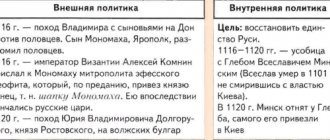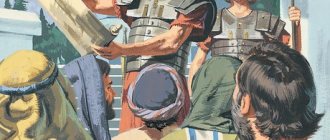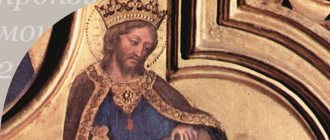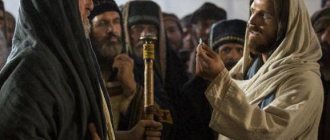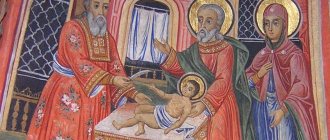Adolescence
At some point, which must be determined individually by each parent, reading the Bible should move to a fundamentally new level. The transition from perception in the form of a fairy tale to analogies and building a connection between Sacred history and modern life is becoming more and more noticeable. During the middle and high school years, the emphasis shifts from imparting knowledge to building relationships in Christ. It becomes necessary to bring the Gospel into our daily lives and reflect its relevance in modern conditions. The good news should not remain a fairy tale, but should become a faithful companion in life for a young Christian.
Adolescence, due to its spirit of protest, needs stories that highlight individuals. A teenager needs to be told about personalities, about those people who entered the sacred books to become part of our lives. Each character in Holy Scripture went through a certain path that made him a legendary person. At this stage, it is very important to show that despite any genius, a person still needs the help of the Creator and is not able to achieve holiness on his own. At the same time, the Lord helps everyone who wants to grow.
With teenagers, it is best to read the Bible in the Slavic translation. A good practice is the obligatory weekly reading on Saturday evening - analysis of the Gospel passage read at the Sunday service. Savvy parents can also review Old Testament passages with their children before reading the corresponding proverbs.
For those who are older
K.D. Ushinsky, already mentioned by us, gave the following recommendations. Church life itself disposes us to study Scripture, including through church holidays. The service is combined with the mother’s story and a joyful feeling - all this revives ancient historical events in the children’s imagination.
At the same time, it is better to divide the story into two stages. At the first stage, the child is introduced to the main points of the event; at the second stage, secondary features are added to them. This method allows you to avoid a situation where a child takes away little things from a long story and does not notice the main thing. Of course, when reading together, the clarity of the narrative, feedback through questions, comprehension of what is read, and regularity of activities are important.
Readings should be carried out in such a way that they are not a burden to children. As noted by N.E. Pestov (quoting Ushinsky’s recommendations), it is permissible to engage in some kind of handicraft - drawing, origami, embroidery or something else. But a fussy attitude or a tense environment is unacceptable. We must remember that our goal is to instill in children a love of reading the Word of God, to show them that It is the main compass of life and a means of communication with God. To do this, we must trust Him ourselves and rely on Him, entrusting ourselves and our works.
On the verge of school age...
As mentioned above, for children it is preferable to become familiar with the Holy Scriptures in the form of a story adapted for children. A classic representative of this form of study can be considered the Children's Bible, adapted by Borislav Arapovich and Vera Mattelmäki. Currently, many other books have been published to introduce children to Sacred History, when choosing which it is best to focus on authors and publishing houses blessed by the Orthodox Church.
However, with constant reliance on adapted publications, by the time of primary school age the approach to the study of the Holy Scriptures should undergo some changes.
As children mature, it is recommended that they add some study of the catechism to their reading. The foundations of the Orthodox faith are examined - the commandments of Moses and the Beatitudes, the Symbol of Faith, church services and the Sacraments.
When analyzing sacred history, it is useful to learn to ask questions that teach a teenager to think. For example, why did God not accept Cain's sacrifice? It is worth talking about the need for a reverent attitude towards every matter of communication with God: the Sacraments, prayer and visiting church.
When studying the history of the battle with the Amalekites (Ex. 17:11), it is useful to pay attention to the fact that the success of any human activity depends on God - and therefore one must turn to Him for blessing before any important undertaking.
Returning to the parable of the prodigal son, it is worth noting that throughout life a person often finds himself in the position of a prodigal son. And it is quite possible, even during the course of a day, to depart from the Father more than once through one’s own sins.
It is useful for children of primary school age to be recommended to read books that educate the concept of righteousness. Such holy fathers as Ignatius Brianchaninov, Theodosius of Optina, and Theophan the Recluse at a young age were very fond of reading the lives of Christian ascetics. Subsequently, they noted that what they read sank deeply into their souls and left a mark for the rest of their lives. For example, Ignatius Brianchaninov will write in his notes, turning to God: “Your Pimens, Sysoi and Macarii captivated my soul.” Acquaintance with the life of holy ascetics at an early age protected the future saint from the temptations of youth and directed him to the monastic path of serving God.
Tactile memory
In preschoolers and primary schoolchildren, all three channels of perception of the world are equally developed: auditory, visual and tactile. At the same time, the speed of writing almost always corresponds to the speed of the child’s thinking, which allows him to think about information while writing it. In addition, a complete picture is created that is reliably imprinted in his memory - motor memory is quite reliable and durable.
The stage of early school age can be considered transitional - parents, although not abandoning the study of the Holy Scriptures in an adapted form, can include original quotations from the Synodal translation. You can keep a notebook in which you write down one main quote from each reading.
The role of Holy Scripture in the life of a little Christian
Studying the Bible is an integral part of the life of every Orthodox person. According to legend, the Mother of God loved to read the Holy Books. Christ Himself commands every person to heed His word.
Orthodox doctrine understands the Holy Scriptures as part of the Holy Tradition, which, according to the Orthodox theologian V. N. Lossky, is “the action of the Holy Spirit in the Church.” Sacred Tradition, in addition to texts and written institutions, includes church practice and traditions. And, perhaps, the most important thing in the Holy Tradition is the inexpressible personal spiritual experience that passes from generation to generation. And therefore, one of the tasks of Orthodox parents is to transfer this spiritual experience to their children.
Thus, Holy Scripture is a recorded part of the life of the Holy Spirit in the Church. And therefore it represents the most objective way of a person’s personal communication with God, and it should begin from a very early age.
“He who sows sparingly will also reap sparingly; and he who sows bountifully will also reap bountifully” (2 Cor. 9:6). Every encounter with the Bible is a good seed thrown into a young soul. We cannot be lazy on such an important issue, because we will give an answer at the Last Judgment for what has been entrusted to us. This means that we must try to sow these seeds in good faith. The Lord Himself will bring forth the fruit, so that His promise about those times when “both the sower and the reaper will rejoice together” will be fulfilled (John 4:36).
Parables and Images
One priest said that when a child asked what he should do if he got lost, he answered:
- Stop and pray, and I will find you.
When introduced to the parable of the lost sheep, the child was able to feel it as his own experience. Analogies are necessary at any age - they serve as a tool to show the relevance of Biblical stories for every person and every time.
When a child loses his own toys, he becomes upset and cries. This experience can be used to show God's sorrow for every lost human soul.
It is useful for a growing child to tell parables. The parable of the sower shows by analogy that just as life is born in nature, so good qualities are born in the human soul.
The parable of the workers in the vineyard appeals to the sense of justice that is very developed in children. It is very complex and, at the same time, very useful in view of the fact that it is very difficult to explain equal reward received by employees.
The parable of the prodigal son is very multifaceted. At a younger age, it can be explained in such a way that the prodigal son is the one who is lost and cannot find his way home. This turns the child to personal experience when he himself was lost and could not find his mother. Despite some inaccuracy of interpretation, this meaning will be most accessible to the child.
From a certain age, questions will begin to appear and the process itself will move to a new stage - from simple reverent attention to a discussion of what has been read. Here the second question arises: how to introduce children to Sacred History?

